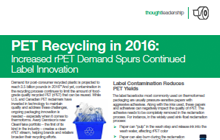In the last decade, there’s been a growing push by consumers and consumer groups for greener and more sustainable products. This has caused U.S. and Canadian brands and retailers to make the recyclability of product packaging a bigger priority. The demand is there:
- Companies want to add post-consumer recycled content to their PET packaging to help position themselves as good environmental stewards.
- The demand for recycled content is up for packaging beverages, dairy, electronics, household care, over-the-counter pharmaceuticals, personal care products and snacks.
- The growing market for PET thermoform recycling is represented by cups, clamshells, trays, tubs, boxes, lids, egg cartons and similar packages made from plastic sheet.
According to the latest data available, in 2014, PET thermoforms collected for recycling in the U.S. and Canada broke the 100-million-pound mark, an increase of 70 percent over 2013’s 60.4 million. Yet despite this dramatic increase, obstacles to PET thermoform recycling remain, making the supply less than the demand.
|
The label facestocks most commonly used on PET thermoformed packaging are usually pressure-sensitive papers with aggressive adhesives. Along with the inks used, these papers and adhesives can negatively impact the quality of rPET.
The adhesive needs to be completely removed in the reclamation process. For instance, in the widely used sink-float reclamation process:
- Paper can “pulp” in the wash step and release ink into the wash water, affecting rPET color
- Paper can also burn during the reclamation process, creating unwanted dark specs in the recycled plastic
- Label, adhesive and/or ink can sink with the PET and be mixed with the PET flake
- Any residual adhesive on the PET flake discolors it in the melt extrusion step
|
CleanFlake™ adhesive technology for paper and film provides a robust solution for retailers and brand owners that contributes to the recyclability and reusability of their PET thermoform packaging, for sustainable packaging design. When these companies invest in and promote label technologies that reduce contamination in the recycling stream they enable reclaimers to recoup more quality rPET materials. This positively affects everything from reduced petroleum use, greenhouse gases and energy use, to helping make a brighter future for us all.
*This comprehensive recycling evaluation serves as a performance assessment for labels in the plastic recycling process. Label stock that passes the APR Benchmark Test is a foundation for container decoration that provides the best possible performance in the plastic recycling processes.
|
Avery Dennison has created the only complete, paper construction for PET thermoform packaging that passes the Association of Plastic Recyclers Benchmark criteria, a recycling assessment for PET thermoform labels and adhesives, as verified by third-party testing*.
Avery Dennison’s CleanFlake™ Adhesive technology uses an adhesive that allows the paper facestock, inks and adhesive to cleanly separate from the PET during the reclamation process, thereby increasing the rPET yield. CleanFlake technology is now available in clear or white BOPP film facestocks and a 54-pound, FSC-certified paper facestock. Avery Dennison CleanFlake recyclable adhesive technology contributes to the demand for eco friendly packaging products for today’s earth-conscious consumer.
|



